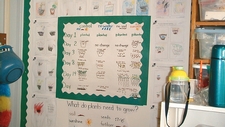Scientific Presentations

TEKS Objective
The student is expected to communicate valid, oral, and written results supported by data.
Essential Understanding
The student uses scientific inquiry methods during laboratory and outdoor investigations.
Science Background
Scientific Communication, Peer Review: Visionlearning (website) - Detailed explanation of the process, purpose and importance of peer review for journal articles, grant submissions and other professional documents created by scientists. Includes references for further reading and links to related learning modules.
Scientific Communication, Peer Review
Visionlearning (website), www.visionlearning.com
Scientific Communication: Scitable (website) - Wealth of information, appropriate for all levels of teachers and students, about creating successful oral, written and poster presentations.
Signature Lesson
Sun Smarts: Young Scientist Challenge (PDF) - Students to play the role of a scientist researching UV radiation, seeking to determine its impact on individuals and society, and using data to communicate findings and strategies to protect ourselves from harmful UV radiation. This activity was a prompt for a past online contest, but it is engaging and appropriate for this TEK.
Sun Smarts
Young Scientist Challenge (PDF), www.youngscientistchallenge.com
- Supporting Lessons
- Extensions
- Assessment Ideas
- Literature Connections
- Related
TEKS - Additional Resources
Supporting Lessons
Break the Tension, A Water Experiment: Education.com (website) - Students experiment with surface tension in water, and then communicate their conclusions verbally and in writing.
Break the Tension, A Water Experiment
Education.com (website), www.education.com
Elaboration Lessons and Extensions
How to Deliver a Good Oral Presentation: Discovery Education (website) - Many students (and adults) find it nerve-wracking, even frightening, to give a public presentation. This article provides guidelines for student science fair presentations, but the broad tips provided can help students (and teachers) to give successful, confident verbal presentations in any setting.
Assessment Ideas
Science Presentation Evaluation Rubric: Tempe Union (AZ) High School District (website) - Use this rubric to score students’ oral, written or poster presentations.
Oral Presentation Rubric: rubistar (website) - Complete rubric including 8 categories at 4 levels.
Oral Presentation Rubric
Rubistar,www.rubistar.4teachers.org
Literature Connections
A+Projects: Winning Experiments for Science Fair. Vancleave, Janice (ISBN-13: 978-0471331025)
What’s the Plan? Designing Your Experiment. Hyde, Natalie (ISBN-13: 978-0778751540)
Additional Resources
Communication and Leadership: BioEd Online (video) - View three videos, by expert Tracy Volz, PhD, to strengthen presentation and professional relations skills: Dynamite PPT Design; Planning and Preparing for a Leadership Presentation; and Enhancing Your Leadership Presence.
Enhancing Your Leadership Presence
BioEd Online, www.bioedonline.org
Planning and Preparing for a Leadership Presentation
BioEd Online, www.bioedonline.org
Dynamite PPT Design
BioEd Online, www.bioedonline.org
Science Notebooks in K-12 Classrooms: Science Notebooks.org (website) - Science notebooks can improve students’ science understanding, while also enhancing their reading, writing, mathematics and communications skills. This site provides examples of student work from science notebooks and tips for using science notebooks in your class.
Science Notebooks in K-12 Classrooms
Science Notebooks.org (website),www.sciencenotebooks.org
TEKS Navigation
Grade 4
Need Assistance?
If you need help or have a question please use the links below to help resolve your problem.

Comments